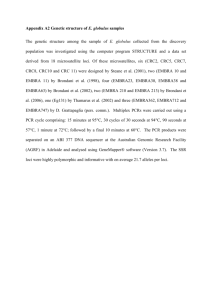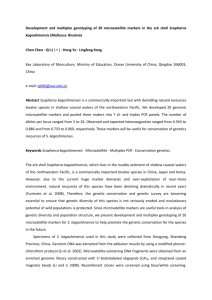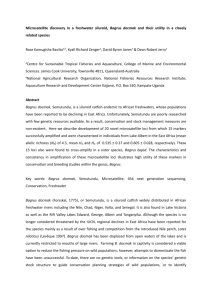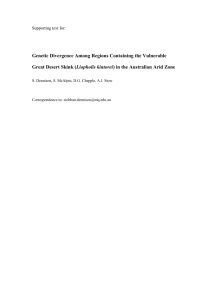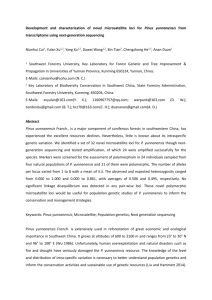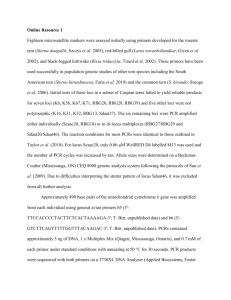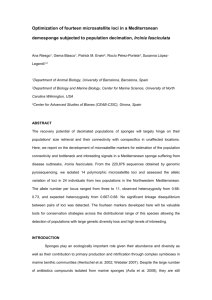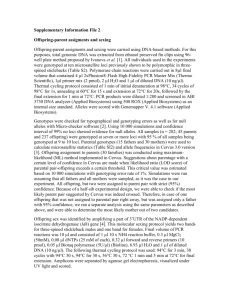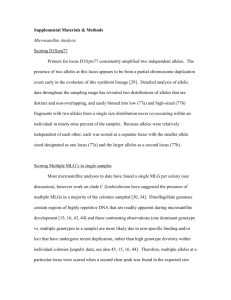Acknowledgments - Springer Static Content Server
advertisement
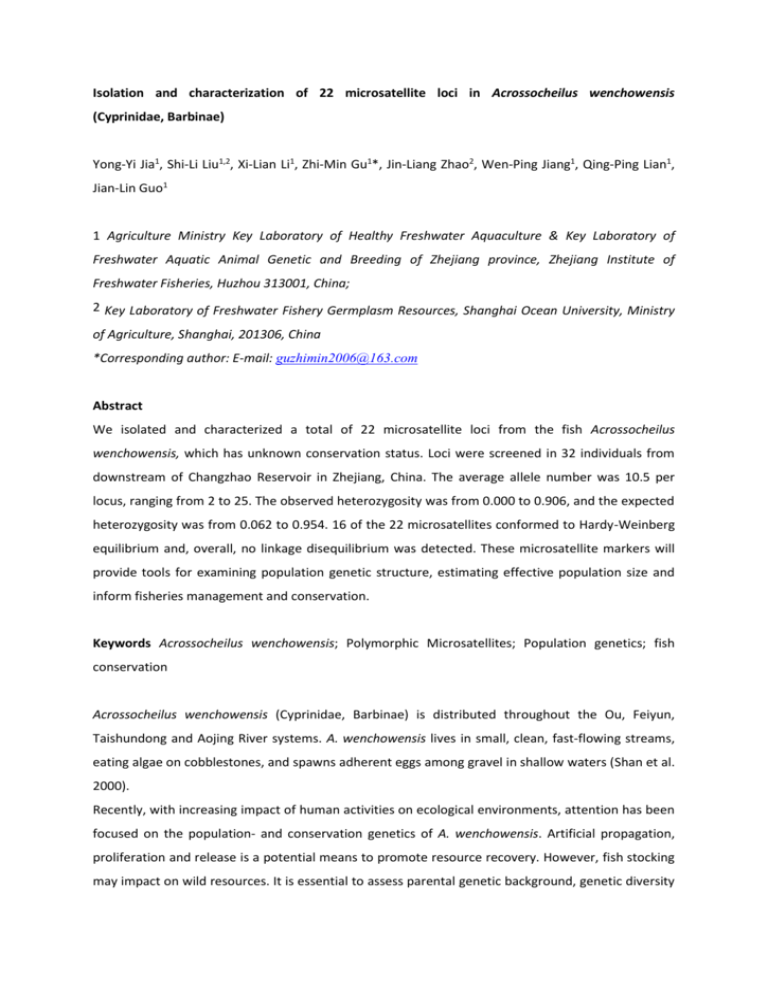
Isolation and characterization of 22 microsatellite loci in Acrossocheilus wenchowensis (Cyprinidae, Barbinae) Yong-Yi Jia1, Shi-Li Liu1,2, Xi-Lian Li1, Zhi-Min Gu1*, Jin-Liang Zhao2, Wen-Ping Jiang1, Qing-Ping Lian1, Jian-Lin Guo1 1 Agriculture Ministry Key Laboratory of Healthy Freshwater Aquaculture & Key Laboratory of Freshwater Aquatic Animal Genetic and Breeding of Zhejiang province, Zhejiang Institute of Freshwater Fisheries, Huzhou 313001, China; 2 Key Laboratory of Freshwater Fishery Germplasm Resources, Shanghai Ocean University, Ministry of Agriculture, Shanghai, 201306, China *Corresponding author: E-mail: guzhimin2006@163.com Abstract We isolated and characterized a total of 22 microsatellite loci from the fish Acrossocheilus wenchowensis, which has unknown conservation status. Loci were screened in 32 individuals from downstream of Changzhao Reservoir in Zhejiang, China. The average allele number was 10.5 per locus, ranging from 2 to 25. The observed heterozygosity was from 0.000 to 0.906, and the expected heterozygosity was from 0.062 to 0.954. 16 of the 22 microsatellites conformed to Hardy-Weinberg equilibrium and, overall, no linkage disequilibrium was detected. These microsatellite markers will provide tools for examining population genetic structure, estimating effective population size and inform fisheries management and conservation. Keywords Acrossocheilus wenchowensis; Polymorphic Microsatellites; Population genetics; fish conservation Acrossocheilus wenchowensis (Cyprinidae, Barbinae) is distributed throughout the Ou, Feiyun, Taishundong and Aojing River systems. A. wenchowensis lives in small, clean, fast-flowing streams, eating algae on cobblestones, and spawns adherent eggs among gravel in shallow waters (Shan et al. 2000). Recently, with increasing impact of human activities on ecological environments, attention has been focused on the population- and conservation genetics of A. wenchowensis. Artificial propagation, proliferation and release is a potential means to promote resource recovery. However, fish stocking may impact on wild resources. It is essential to assess parental genetic background, genetic diversity of offspring proposed to be released, as well as post-release impact on wild populations, so as to adjust stocking strategies appropriately. Each of these tasks requires informative DNA markers. However, current genetic-based research on A. wenchowensis is limited. Microsatellite markers are employed in co-dominant genetic analysis techniques capable of providing significant genetic information and have been widely applied in analyzing genetic diversity of species, phylogenetic analysis, variety identification and evolutionary studies. Although some progress has been made in development of microsatellite markers for the genus of Acrossocheilus (Chen et al. 2012), markers targeting A. wenchowensis have now been developed for the first time in China. In this study, 22 informative microsatellite loci were isolated and characterized, providing a basis for genetic evaluation of A. wenchowensis and formulation of protection policies. Enriched partial microsatellite genomic libraries for repeats motifs (CA)12 and (GT)12 were obtained following Glenn and Schable’s (2005) protocol with minor modifications. Two hundred plasmid clones with different insert lengths were sequenced. Overall, 152 unique sequences were obtained: 96 contained simple sequence repeats and 66 were suitable for primer design using Primer Premier 6.0 (PREMIER Biosoft International). Diversity detection was performed using eight individuals. PCR amplification methods were according to Liu (2014). Fifty-four primer pairs stably amplified, of which 22 pairs revealed apparent polymorphism. We FAM -labelled downstream primers for these 22 pairs and evaluated using 32 A. wenchowensis individuals collected downstream of Changzhao Reservoir in Zhejiang. PCR products were separated on an ABI 3730xl genetic analyzer (Applied Biosystems) with ROX-500 size standards, and analyzed using SoftGenetics’ GeneMarker version 2.2. The numbers of alleles (Na), expected (He) and observed heterozygosities (Ho) as well as conformation to Hardy–Weinberg equilibrium (HWE) were evaluated using software Genepop version 4.0 (Rousset 2008). Locus designation, primer sequences, repeat motifs, numbers of alleles (Na), range of PCR product sizes, and PIC are provided in Table 1. Na ranged from 2 to 25. Ho and He ranged from 0.000 to 0.906 and from 0.062 to 0.954, respectively. Among these polymorphic microsatellite loci, six (Awc 014, Awc 041, Awc 043b, Awc 051, Awc 070 and Awc 071) showed significant deviations (P < 0.05) from HWE after sequential Bonferroni correction. No evidence was found for linkage disequilibrium among loci at a 5% significance level. These polymorphic microsatellite markers may be used as powerful tools for investigating genetic diversity and genetic structure in A. wenchowensis. Acknowledgments This work was supported by grants from the Public Welfare Agricultural Research Project (No. 2011C2208), and the Cultivating Innovation Support Project (No. 2014F13307) of Zhejiang Science and Technology Department. References Chen L, Li Z, Chen X et al (2012) Isolation and characterization of 15 microsatellite loci in Acrossocheilus labiatus Regan (Cyprinidae). Conservation Genet Resour 4:167-169. doi:10.1007/s12686-011-9500-x Glenn TC, Schable NA (2005) Isolating microsatellite DNA loci. Methods Enzymol 395:202-222. doi:10.1016/S0076-6879(05)95013-1 Liu SL, Gu ZM, Jia YY et al (2014) Isolation and characterization of 32 microsatellite loci for topmouth culter (Culter alburnus Basilewsky). Genet Mol Res 13: 7480-7483. doi:10.4238/2014.September.12.14 Rousset F (2008) Genepop'007: a complete re-implementation of the gene pop software for Windows and Linux. Mol Ecol Resour 8:103-106. doi: 10.1111/j.1471-8286.2007.01931.x Shan XH, Lin RD, Yue PQ et al (2000) Barbinae. In: Yue PQ, editor. Fauna sinica (Osteichthyes: Cypriniformes III). Beijing: Science Press. (in Chinese) p 3-107.

